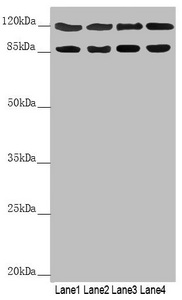Full Product Name
Rabbit anti-Homo sapiens (Human) SCYL1 Polyclonal antibody
Alternative Names
Coated vesicle associated kinase of 90 kDa antibody; Coated vesicle-associated kinase of 90 kDa antibody; CVAK90 antibody; GKLP antibody; HT019 antibody; Likely ortholog of mouse N terminal kinase like protein antibody; MGC78454 antibody; N terminal kinase like antibody; N terminal kinase like protein antibody; N-terminal kinase-like protein antibody; NKTL antibody; NTKL antibody; NTKL_HUMAN antibody; NTKLBP1 antibody; P105 antibody; SCY L1 antibody; SCY1 like 1 antibody; SCY1 like 1 protein 1 antibody; SCY1-like protein 1 antibody; SCYL 1 antibody; Scyl1 antibody; SCYL1BP1 antibody; TAPK antibody; TEIF antibody; Telomerase regulation associated protein antibody; Telomerase regulation-associated protein antibody; Telomerase transcriptional element interacting factor antibody; Telomerase transcriptional element-interacting factor antibody; Teratoma associated tyrosine kinase antibody; Teratoma-associated tyrosine kinase antibody; TRAP antibody
Immunogen
Recombinant Human N-terminal kinase-like protein (460-740AA)
Immunogen Species
Homo sapiens (Human)
Purification Method
Antigen Affinity Purified
Concentration
It differs from different batches. Please contact us to confirm it.
Buffer
PBS with 0.02% sodium azide, 50% glycerol, pH7.3.
Tested Applications
ELISA, WB
Recommended Dilution
| Application |
Recommended Dilution |
| WB |
1:1000-1:5000 |
Storage
Upon receipt, store at -20°C or -80°C. Avoid repeated freeze.
Lead Time
Basically, we can dispatch the products out in 1-3 working days after receiving your orders. Delivery time maybe differs from different purchasing way or location, please kindly consult your local distributors for specific delivery time.
Usage
For Research Use Only. Not for use in diagnostic or therapeutic procedures.






